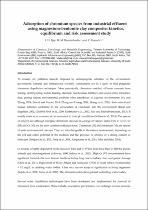 ResearchSpace
ResearchSpace
Adsorption of chromium species from industrial effluent using magnesium-bentonite clay composite: kinetics, equilibrium and risk assessment study
JavaScript is disabled for your browser. Some features of this site may not work without it.
- ResearchSpace
- →
- Research Publications/Outputs
- →
- Conference Publications
- →
- View Item
| dc.contributor.author |
Tjia, FH

|
|
| dc.contributor.author |
Ramakokovhu, MM

|
|
| dc.contributor.author |
Masindi, Vhahangwele

|
|
| dc.date.accessioned | 2018-02-12T09:53:26Z | |
| dc.date.available | 2018-02-12T09:53:26Z | |
| dc.date.issued | 2017-07 | |
| dc.identifier.citation | Tjia, F.H., Ramakokovhu, M.M. and Masindi, V. 2017. Adsorption of chromium species from industrial effluent using magnesium-bentonite clay composite: kinetics, equilibrium and risk assessment study. SAIMM Water 2017: Lifeblood of the Mining Industry, 10-11 July 2017, Emperors Palace, Johannesburg, South Africa | en_US |
| dc.identifier.uri | http://www.saimm.co.za//media/com_eventbooking/Water%20-%20final%20programme%2004072017.pdf | |
| dc.identifier.uri | http://hdl.handle.net/10204/10031 | |
| dc.description | Paper presented at SAIMM Water 2017: Lifeblood of the Mining Industry, 10-11 July 2017, Emperors Palace, Johannesburg, South Africa | en_US |
| dc.description.abstract | To counter for pollution hazards imposed by anthropogenic activities on the environment, government, national and international scientific communities are in a quest to find pragmatic chromium depollution techniques. More prevalently, chromium enriched effluents emanate from mining, electroplating, leather tanning, chromite beneficiation, fertilizer and several other industries, thus, posing serious environmental problem when introduced to aqueous environments (Yu and Zhang, 2014, Zewail and Yousef, 2014, Zhang and Huang, 2014, Zhang et al., 2014). Both natural and human activities contribute to the introduction of chromium into the environment (Baral and Engelken, 2002, Ghorbel-Abid et al., 2009, Fabbricino et al., 2013, Zuo and Balasubramanian, 2013). It mainly exists as an oxyanion at circumneutral to basic pH conditions (Sultana et al., 2014). The species of concern are although inorganic chromium can exist in a range of valence states from 2+ to 6+, Cr (III) and Cr (VI) are the most common oxidation states. Chromium (III) and chromium (VI) are species of main environmental concern. They are interchangeable in the natural environment, depending on the pH and redox potential of the medium and the presence or absence of a strong oxidant or reductant (Rengaraj et al., 2001, Peng et al., 2014, Rangasamy et al., 2014, Saha and Saha, 2014). | en_US |
| dc.language.iso | en | en_US |
| dc.relation.ispartofseries | Worklist;19669 | |
| dc.subject | Chromium depollution techniques | en_US |
| dc.subject | Chromium (III) | en_US |
| dc.subject | Chromium (VI) | en_US |
| dc.subject | Pollution hazards | en_US |
| dc.subject | Adsorption models | en_US |
| dc.subject | Mechanochemical synthesis | en_US |
| dc.title | Adsorption of chromium species from industrial effluent using magnesium-bentonite clay composite: kinetics, equilibrium and risk assessment study | en_US |
| dc.type | Conference Presentation | en_US |
| dc.identifier.apacitation | Tjia, F., Ramakokovhu, M., & Masindi, V. (2017). Adsorption of chromium species from industrial effluent using magnesium-bentonite clay composite: kinetics, equilibrium and risk assessment study. http://hdl.handle.net/10204/10031 | en_ZA |
| dc.identifier.chicagocitation | Tjia, FH, MM Ramakokovhu, and Vhahangwele Masindi. "Adsorption of chromium species from industrial effluent using magnesium-bentonite clay composite: kinetics, equilibrium and risk assessment study." (2017): http://hdl.handle.net/10204/10031 | en_ZA |
| dc.identifier.vancouvercitation | Tjia F, Ramakokovhu M, Masindi V, Adsorption of chromium species from industrial effluent using magnesium-bentonite clay composite: kinetics, equilibrium and risk assessment study; 2017. http://hdl.handle.net/10204/10031 . | en_ZA |
| dc.identifier.ris | TY - Conference Presentation AU - Tjia, FH AU - Ramakokovhu, MM AU - Masindi, Vhahangwele AB - To counter for pollution hazards imposed by anthropogenic activities on the environment, government, national and international scientific communities are in a quest to find pragmatic chromium depollution techniques. More prevalently, chromium enriched effluents emanate from mining, electroplating, leather tanning, chromite beneficiation, fertilizer and several other industries, thus, posing serious environmental problem when introduced to aqueous environments (Yu and Zhang, 2014, Zewail and Yousef, 2014, Zhang and Huang, 2014, Zhang et al., 2014). Both natural and human activities contribute to the introduction of chromium into the environment (Baral and Engelken, 2002, Ghorbel-Abid et al., 2009, Fabbricino et al., 2013, Zuo and Balasubramanian, 2013). It mainly exists as an oxyanion at circumneutral to basic pH conditions (Sultana et al., 2014). The species of concern are although inorganic chromium can exist in a range of valence states from 2+ to 6+, Cr (III) and Cr (VI) are the most common oxidation states. Chromium (III) and chromium (VI) are species of main environmental concern. They are interchangeable in the natural environment, depending on the pH and redox potential of the medium and the presence or absence of a strong oxidant or reductant (Rengaraj et al., 2001, Peng et al., 2014, Rangasamy et al., 2014, Saha and Saha, 2014). DA - 2017-07 DB - ResearchSpace DP - CSIR KW - Chromium depollution techniques KW - Chromium (III) KW - Chromium (VI) KW - Pollution hazards KW - Adsorption models KW - Mechanochemical synthesis LK - https://researchspace.csir.co.za PY - 2017 T1 - Adsorption of chromium species from industrial effluent using magnesium-bentonite clay composite: kinetics, equilibrium and risk assessment study TI - Adsorption of chromium species from industrial effluent using magnesium-bentonite clay composite: kinetics, equilibrium and risk assessment study UR - http://hdl.handle.net/10204/10031 ER - | en_ZA |





